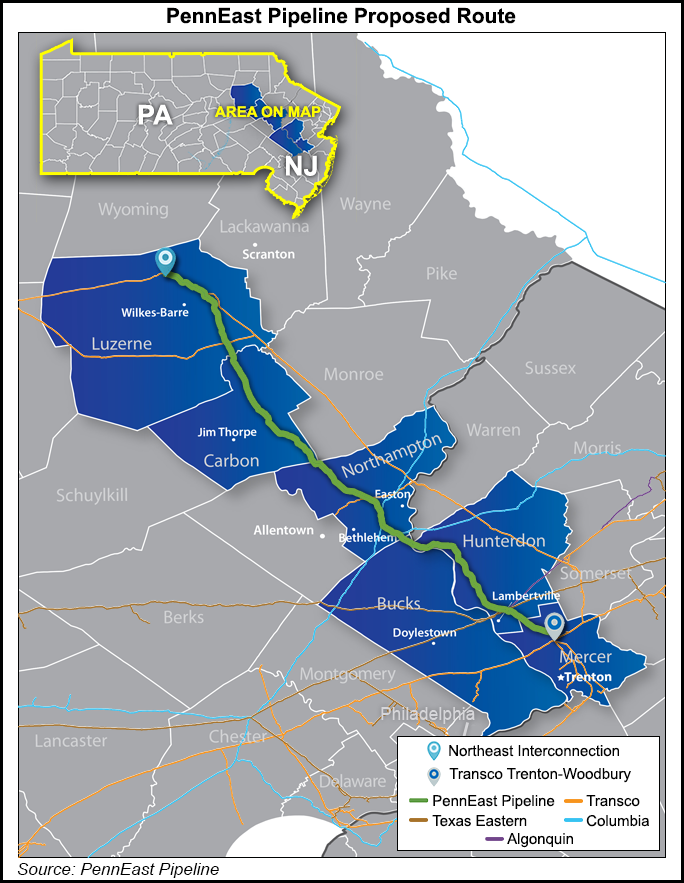Utica Shale | E&P | Marcellus | NGI All News Access | Regulatory
Enviros Ask FERC to Withdraw PennEast Pipeline Application
In another effort to stop the PennEast Pipeline from advancing, the New Jersey Conservation Foundation (NJCF) and Stony Brook-Millstone Watershed Association (SBMWA) on Monday requested that FERC withdraw the application and consider a “no-action alternative.”

The conservation organizations asked the Federal Energy Regulatory Commission to respond to a bevy of environmental concerns about the project raised by several state and federal agencies and environmental groups, charging as others have that the project’s draft environmental impact statement (DEIS) is incomplete because it used “outdated maps and omitted impacted areas.”
“It would be unacceptable for the review process to proceed in light of the alarming information submitted by key state and federal agencies and experts, and the existing alternatives identified that can meet the stated needs of the project without requiring consumers to pay for an unneeded pipeline, and without damaging our land, water and communities, and without the condemnation of more than 500 landowners,” said NJCF campaign director Tom Gilbert.
The New Jersey Rate Counsel, U.S. Fish & Wildlife Service, the Department of the Interior and the New Jersey Department of Environmental Protection have all raised concerns about the project. More recently, the Environmental Protection Agency (EPA) and the National Park Service (NPS) filed comments with FERC claiming the DEIS lacked the information necessary for the public to better understand the project (see Daily GPI, Sept. 13). The EPA raised concerns about the alternatives analysis and the pipeline’s cumulative environmental impacts, while the NPS was primarily concerned about the pipeline crossing the 2,189-mile Appalachian Trail in Eastern Pennsylvania.
The conservation organizations said those comments and others should be enough to withdraw the application and consider a no-action alternative, which would mean evaluating environmental effects if the project didn’t go forward or another took its place.
PennEast spokeswoman Patricia Kornick said regulatory agencies typically provide input during the FERC review process that they believe can advance efforts to minimize environmental impacts. The conservation groups said 30 minor route modifications that PennEast submitted last week don’t change anything because the DEIS is shortsighted and FERC failed to adequately respond to more than 3,000 comments during the public comment period (see Shale Daily, Sept. 23).
The groups noted that comments submitted during that time suggest that naturally-occurring arsenic could leak into drinking water supplies in New Jersey during construction, a drinking water reservoir could be impacted and a variety of wildlife and plant species living along the route have not been adequately documented.
“We must stop this pipeline from going into the ground where it would be a direct threat to critical water supplies,” said SBMWA Executive Director Jim Waltman.
PennEast cited ongoing efforts to reduce effects on endangered species, wetlands and landowners after it filed the route modifications, which Kornick said were responsive to constructive feedback provided by landowners, agencies and other stakeholders. She added that since the modifications occur either within the original survey corridor or do not impact new landowners, they don’t require an extended or new review.
“Those opposed to natural gas development have demonstrated regularly that they will stop at little to advance their own agendas, much of which falls under the guise of environmental protection and promoting renewable energy,” Kornick said. “…Though clearly vocal, those in opposition to natural gas pipeline projects do not represent the majority.”
Proposed in 2014, the 119-mile PennEast pipeline is a joint venture owned by six companies and managed by UGI Energy Services. It would transport 1.11 million Dth/d of Marcellus Shale gas to markets in Pennsylvania and New Jersey. Capacity on the system has mainly been secured by utilities.
© 2024 Natural Gas Intelligence. All rights reserved.
ISSN © 2577-9877 | ISSN © 2158-8023 |
